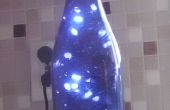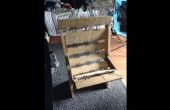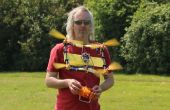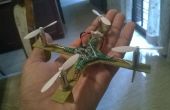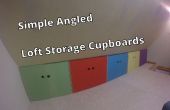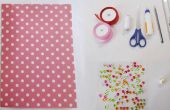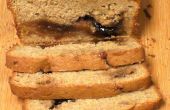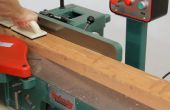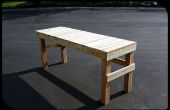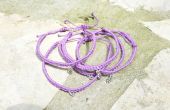Stap 3: Xoscope vluggertje handleiding.
NAAM oscope xoscope - digitale oscilloscoop via Sound Card of andere HardwareSYNOPSIS
oscope [oscope options] [file] xoscope [toolkit options] [oscope options] [file]
BESCHRIJVING
Oscope is a digital real-time oscilloscope. It graphically displays signal amplitude or bit logic as a function of time. Signals may be displayed, saved, recalled, and manipulated by math functions. Signal input devices currently include: /dev/dsp Audio sound recording via /dev/dsp. Two 8-bit analog channels at 8000 S/s to 44100 S/s. Left and right audio is connected to X and Y inputs respectively. Use an external mixer program to select which sound inputs to record. AC coupled, voltages unknown, 256K sample memory. EsounD Shared audio sound via the Enlightened Sound Daemon. This is great for watching music but support for it is an option at com pile-time. EsounD is auto-detected and preferred over /dev/dsp. ProbeScope / OsziFOX Radio Shack ProbeScope, Cat. No. 22-310 is also known as an oszi FOX. This handheld probe sends its data through a serial port. It samples one channel at 6-bits up to 20 MS/s with 128 samples of memory. Real voltages are labeled in sample ranges from 1 volt to 100 volts. If a ProbeScope is detected, it is connected to the Z input. Bitscope Bitscope (www.bitscope.com) is a mixed-signal capture engine which is accessed through a serial port. It simultaneously samples a digital 8-bit port and two analog channels at 8 bit resolution at up to 25 MS/s or more. If detected, Channel A and B are connected to X and Y while the Logic Analyzer is connected to Z, disabling all sound input. Bitscope support is currently under development and not yet fully functional. See the -x and -z options and the ENVIRONMENT section below for more details on how the above devices are detected. Some of the controls below apply only to the sound card and are labeled as such. Oscope has no physical control over the ProbeScope/osziFOX which is controlled by its own switches and built-in menus. Please refer to your ProbeScope or osziFOX Owner’s Manual for operating instructions. Bitscope will eventually be controlled through a separate dialog window. Oscope is an interactive program and can be completely controlled from the keyboard at run-time. In verbose key help mode, each available key is shown on the screen in (parentheses). The following single key com mands are available: ? Toggle verbose key help display mode. Escape Immediately quit the program. @ Load a previously saved file. You are prompted for the filename. # Save current settings and memory buffers to a file that can be loaded later. You are prompted for the filename and asked for confirmation to overwrite if it already exists. Enter Clear and refresh the entire screen. ^ Toggle the serial input device on/off. A serial device is turned on only if it is found active on a serial port. This may be use ful if the device was not detected at startup. See the ENVIRON MENT section below for more details. & Toggle the sound card input device on/off. * Cycle the sound card DMA divisor: 4, 2, 1. The sound driver will divide it’s DMA buffer by this factor. The value 4 usually gives the fastest display rate. Under EsounD, this value instead determines whether the connection to EsounD will block (4) or not (2 or 1). Blocking mode is nicest to CPU usage but the oscope interface will not respond when the there is no sound stream coming from EsounD. Nonblocking mode will let oscope be responsive whether sound is available or not, but will consume all available CPU cycles. (/) Decrease/increase the sound card sampling rate. 9/0 Increase/decrease the Sec/Div horizontal time scale (zoom out/in on time). -/= Decrease/increase the sound card trigger level. _ Toggle the sound card trigger channel: X or Y. + Cycle the sound card trigger type: automatic, rising edge, or falling edge. Space Cycle the trigger mode of the sound card: run, wait, stop. Run mode continuously acquires and displays samples after trigger events. Wait mode waits for the first trigger event and displays only the first set of samples; this is "single-shot" mode. Stop mode suspends the data acquisition and displays the current sam ples. ! Cycle the plotting mode: point, point accumulate, line, or line accumulate. In the accumulate modes, all samples stay on the screen; use Enter to clear them. , Cycle the graticule style: none, minor divisions only, or minor and major divisions. . Toggle the graticule position: behind or in front of the signals. Decrease/increase the graticule color. Toggle the manual cursors on/off. When manual cursors are dis played, the measurements between the cursor positions are shown. When cursors are not displayed, automatic measurements are shown. " Reset both manual cursor positions to the sample just after trig ger. Ctrl-q/w/e/r The Control key held down in combination with q/w/e/r moves the first cursor back or forward by 10 samples or back or forward by 1 sample respectively. Ctrl-a/s/d/f The Control key held down in combination with a/s/d/f moves the second cursor back or forward by 10 samples or back or forward by 1 sample respectively. 1-8 Select the corresponding display channel. Measurements are dis played for the channel. Channel 1 and 2 are used as input to the math functions so they can’t be used to do math. By default, they are connected to the X and Y input channels. Channel 1 and 2 can also be used to display memory buffers or the Z input for doing math on memory or the alternate input. Channel 3 through 8 are not restricted and can be used for any purpose. By default, the Z input is connected to Channel 3. The remaining single key com mands operate on the currently selected channel: Tab Toggle visibility: Hide or show the selected channel. {/} Decrease/Increase vertical scale of the selected channel. [/] Decrease/Increase vertical position of the selected channel. /~ Decrease/Increase number of logic analyzer bits displayed. The default of zero bits plots the signal as one analog line of vary ing amplitude. Any other value plots multiple digital lines rep resenting the least significant bits from bottom to top. ;/: Increase/Decrease the math function of the selected channel. This is not available on channel 1 & 2. $ Show the result of an external math command on the selected chan nel. You are prompted for the command. The command must accept samples of channel 1 & 2 on stdin and write a new signal to std out. See operl, offt.c and xy.c in the distribution for examples of external math filter commands. Not available on channel 1 & 2. A-W Store the currently selected channel into the corresponding memory buffer. Buffer X, Y and Z can not be used because they’re reserved as the signal inputs. Memories are stored from time zero to the current display update position. So it is best to STOP the display before storing to a memory buffer. a-z Recall the corresponding memory buffer or input device to the cur rently selected channel. Buffer X is the Left or A input, Y is the Right or B input, and Z is ProbeScope or Logic Analyzer input. The rest of the buffers are available for signal memory. Xoscope adds mouse controls to menus or around the edges of the scope area. These should be nearly self-explanatory. They perform the same functions as the equivalent keyboard commands above. If built with GTK+, a context-sensitive pop-up menu is available with right-click to select channels, change scale and position, recall and store signals and so on. Left click decreases a variable while right click increases. The manual measurement cursors can also be positioned with the mouse. The command-line options define the startup state of oscope and have reasonable defaults. All options may be capitalized in case they con flict with an X toolkit option. These options are also recorded in text files saved by oscope. -h Help usage message showing these startup options with their default values, then exit. -# Startup conditions of each channel. # is a channel number from 1 to 8. Code can have up to three fields, separated by colons: position[.bits][:scale[:function #, memory letter, or external command]]. Position is the number of pixels above (positive) or below (negative) the center of the display. Bits is the number of logic analyzer bits to display. Scale is a valid scaling factor from 1/50 to 50, expressed as a fraction. The third field may contain a built-in math function number, memory letter, or exter nal math command to run on the channel. Using these options makes the channel visible unless position begins with a ’+’, in which case the channel is hidden. -a Active, or selected, channel. -r Sound card sampling Rate in samples per second. Current valid values are 8000, 11025, 22050, or 44100. -s Time Scale factor from 1/20 to 1000 expressed as a fraction where 1/1 is 1 ms/div. -t Sound card Trigger conditions. Trigger can have up to three fields, separated by colons: position[:type[:channel]]. Position is the number of pixels above (positive) or below (negative) the center of the display. Type is a number indicating the kind of trigger, 0 = automatic, 1 = rising edge, 2 = falling edge. Chan nel should be x or y. -l Manual cursor Line positions. Cursors can have up to three fields, separated by colons: first[:second[:on?]]. First is the sample position of the first cursor. Second is the sample posi tion of the second cursor. The final field is weather the manual cursors are displayed (1) or the not displayed (0). -c Graticule Color, 0 - 15. -d Divisor for sound card DMA: 1, 2, or 4. The sound driver will divide it’s DMA buffer by this factor. The value 4 usually gives the fastest display rate. -m Graphics Mode to use. For xoscope, use the more flexible -geome try instead. 0 = 640x480x16, 1 = 800x600x16, 2 = 1024x768x16, 3 = 1280x1024x16. WARNING: not all modes are supported by all video cards; don’t use unsupported modes! -f Font to use. For oscope, these are listed in /usr/lib/kbd/con solefonts. For xoscope, they’re the output of xlsfonts. The default should work best. -p Plot type. 0 = point, 1 = point accumulate, 2 = line, 3 = line accumulate, 4 = step, 5 = step accumulate. -gGraticule style. 0 = none, 1 = minor divisions only, 2 = minor and major divisions. -b Whether the graticule is drawn Behind or in front of the signals. -v Whether the Verbose key help is displayed. -x Whether the sound card input device (XY) is turned on. This can be used to skip the attempt to connect to Esound or /dev/dsp. -z Whether the serial input device (Z) is turned on. This can be used to suppress the search for a serial scope device. file The name of a file to load upon startup. This should be a file previously saved by oscope. oscope -1 80 -2 -80 -3 0:1/5:6 -4 -160:1/5:7 This runs oscope with channel 1 above and channel 2 below the center of the display. Also channel 3 and 4 are made visible to show the FFT of channel 1 and 2 respectively at a reduced scale of 1/5. xoscope oscope.dat This runs xoscope, loading settings and memory buffers from a pre viously saved data file called "oscope.dat". Oscope creates readable text data files. The files contain at least a comment header which holds the current settings of oscope. Loading the file causes these saved settings to be restored. To record your signals permanently first store them into memory buffers, optionally recall them to channels, and then save the file. All non-empty memory buffers are written to a column of the file fol lowing the comment header. Columns are separated by tab characters. These are stored back into the memory buffers when the file is later loaded. Simply recall them to channels to view them. This format could also be read by some spreadsheet or plotting pro grams. For example, the gnuplot (1) command plot "oscope.dat" using 0:1, "oscope.dat" using 0:2 would plot the first and second columns of the "oscope.dat" data file. OSCOPEPATH The path to use when looking for external math commands. If unset, the built-in default is used. PROBESCOPE The serial device your ProbeScope or osziFOX is connected to. If no ProbeScope is found here, some known serial devices are checked. If unset, /dev/probescope is used. /dev/probescope could be a symbolic link to the real device such as /dev/ttyS1. BITSCOPE The serial device your Bitscope is connected to. If no Bitscope is found here, some known serial devices are checked. If unset, /dev/bitscope is used. /dev/bitscope could be a symbolic link to the real device such as /dev/ttyS1. ESPEAKER The host:port of the EsounD to connect to if built with EsounD support. If unset, localhost is assumed. If no EsounD connection is made or if there is no EsounD support compiled in, then oscope will try to read /dev/dsp directly. The sound card should be capable of 44100 Hz sampling via the sound drivers. You must use an external mixer program to select the input source device, level, etc. Since these unknowns affect the amplitude, there is no reference to voltage on the Y axis; it is in fact, unknown. Instead youre given the scale in pixels per sample unit. Note that the serial oscilloscope devices dont have this limitation. They have real voltage labels on the Y axis. Signal math is only valid if Channel 1 and 2 contain signals of the same sampling rate. It is up to you to make sure this is the case. Doing math on signals of different sample rates will produce incorrect results! The automatic measurements count zero crossings and divide to determine the frequency and period. If these zero crossings are not "regularly- periodic", these measurements could be invalid. Oscope does understand how to measure the built-in FFT functions by locating the peak fre quency. Use manual cursor positioning to get more precise measure ments. Your sound card is most-likely AC coupled so you will never see any DC offset. You probably cant get DC coupling by just shorting the input capacitors on your sound card. Use serial hardware to see DC offsets. The display may not be able to keep up if you give it too much to plot, depending on your sound card, graphics card, and processor speed. External math commands are particularly expensive since the kernel must then split the available CPU cycles across multiple processes. To max imize refresh speed, hide all unneeded channels, use point or point accumulate mode, zoom in on Sec/Div as much as possible, and turn off the graticule. Because it uses svgalib, oscope must be run as root or be setuid to root. xoscope doesnt have this restriction. The keyboard interface may be confusing. Oscope was written by Tim Witham (twitham originally based on "scope" by Jeff Tranter (Jeff_Tranter Oscope is released under the conditions of the GNU General Public License. See the files README and COPYING in the distribution for details.
